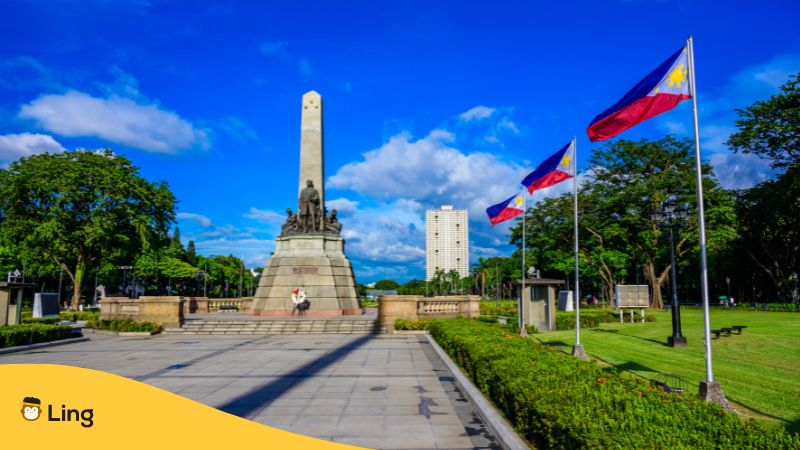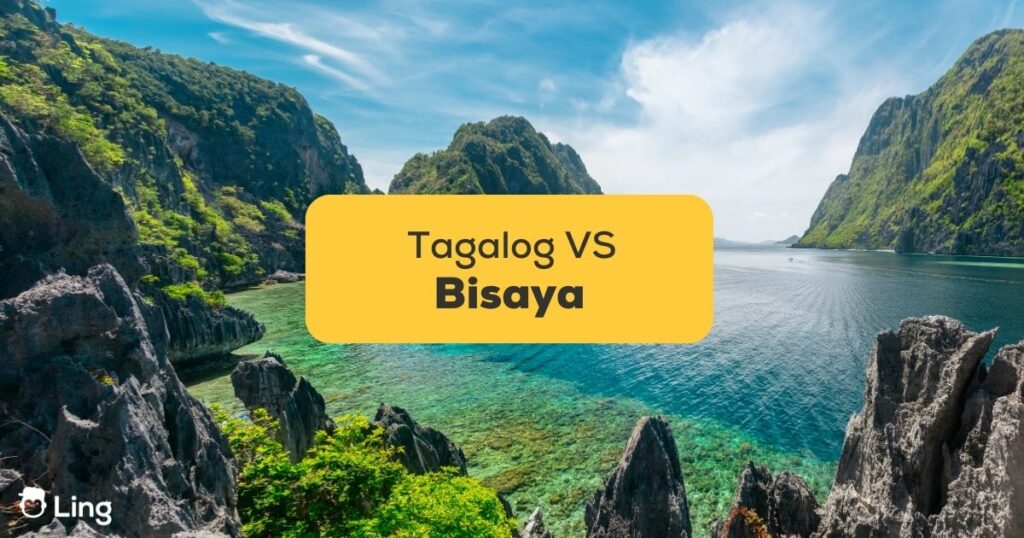While Filipino (based on Tagalog) is the national language of the Philippines, many of the country’s famous beaches are in the Visayas region, where the locals speak Bisaya. And so things brings us to the question: Tagalog words vs Visayan words – which dialect should you familiarize yourself with first when visiting the country? I’d say both! Come on, since you’re already in the Philippine archipelago, you might as well explore most of the tourist spots it cradles, from Tagalog-speaking regions to Visayan-speaking places.
What’s the difference between the two, and how hard can it be to learn both Tagalog and Bisaya? Let’s learn here in this post!

Understanding Tagalog And The Visayan Languages
With more than 170 languages spoken across 7,000+ islands in the Philippines, with the official languages being Filipino and English, it showcases linguistic diversity. Language, deeply intertwined with culture and identity, plays a significant role in preserving heritage and nurturing a sense of belonging.
Amidst this blend of various languages, two prominent ones shine – Bisaya or Cebuano and Tagalog. Tagalog is the main language of the Philippines, and it acts as a bridge connecting people from different backgrounds, enabling effective communication and unity. Tagalog’s phonology, characterized by a wide range of vowels and consonants, adds a musical element to conversations with any Tagalog speaker. The grammar, a complex interplay of affixes, verbs, and particles, flows elegantly through sentences. Tagalog syntax takes on an artistic role, with the verb often driving the flow of conversation.
Beyond Metro Manila and Luzon’s shores, the Cebuano-spoken and Visayan languages flourish, echoing the cultural essence of the Visayas and Mindanao regions. The Visayan languages are comprised of a group of related tongues of native speakers, including Bisaya, Hiligaynon, and Cebuano. Among these closely related dialects, the most widely spoken Bisaya is the Cebuano language, which justifies why learning Cebuano terms can come in handy. Native Cebuano speakers are situated on Cebu island. They use the standard Cebuano dialect as a lingua franca, but most of them are also fluent in English, and some know modern Tagalog, especially those living in Metro Cebu.

You may find a native speaker of Bisayan languages, including Waray-Waray, in eastern Visayas, Southern Leyte, Davao region, and more. It’s also likely to meet people who can speak Cebuano and Tagalog or use them as their major languages despite being raised in the Visayan region.
Although the Visayan languages share a similar linguistic lineage as Tagalog, they offer an array of dialects and subtleties. It’s typical to encounter a Cebuano word with the same meaning or different meaning in Tagalog or vice versa. The lexicon of the Visayan languages abounds with words that encapsulate the essence of local life and emotions. Visayan proverbs and sayings carry the wisdom of generations, offering insights into local culture and values.
Tagalog Words Vs Visayan Words
Now it’s time to learn Tagalog and Visayan or Cebuano words and phrases you may find useful when traveling the beautiful islands of the Philippines from north to south. By familiarizing yourself with Cebuano dialects and what they mean in Tagalog or Tagalog to Bisaya, it will be easier to go around and speak Tagalog when meeting Tagalog speakers and flex Visayan terms when you’re in the Visayas region.
| English | Tagalog | Bisaya |
| Good morning | Magandang umaga | Maayong buntag |
| Good day | Magandang araw | Maayong adlaw |
| Thank you very much | Maraming salamat | Daghang salamat |
| You’re welcome | Walang anuman | Wala ra to/Walay sapayan |
| This | Ito | Kani/Ni |
| That | Iyon | Kana/Na |
| Please | Paki | Palihug |
| Yes | Oo | Oo |
| No | Hindi | Dili |
| What is your name? | Ano’ng pangalan mo? | Unsa imong ngalan? |
| My name is _____. | Ang pangalan ko ay _____. | Ang akong ngalan si _____. |
Phrases Commonly Used When Traveling To Places
| English | Tagalog | Bisaya |
| Where do I get off? | Saan ako bababa? | Asa ko manaog? |
| How much? | Magkano? | Tagpila? |
| Where is the bus stop? | Saan hihinto ang mga bus? | Asa ang atanganan og bus? |
| How much is the fare? | Magkano ang pamasahe? | Tagpila ang plete? |
| What is this? | Ano ito? | Unsa ni? |
| See you later | Kita tayo mamaya | Kita lang ta unya |
Words And Phrases Related To Dining
| English | Tagalog | Bisaya |
| Delicious | Masarap | Lami |
| That was a good meal | Masarap ang pagkain | Kalami sa pagkaon |
| Let’s eat | Kain tayo | Mangaon ta |
| I have no appetite | Wala akong gana | Wala koy gana |
| I’m thirsty | Nauuhaw ako | Gi-uhaw ko |
| I’m hungry | Nagugutom ako | Gigutom na ko |
Confusing Words In Tagalog And Bisaya
Like in English and many other foreign languages, there are Tagalog words that mean differently in Bisaya and vice versa. So make sure that you use these words with caution depending on where you are in the Philippines and if you’re talking with a native Tagalog or Bisaya speaker:
“Bitaw“
In Tagalog, “bitaw” means to let go.
In Bisaya, the word is used as an expression that means “talaga” or really.
“Utong“
This word means nipple in Tagalog.
In Bisaya, “utong” means holding your breath while forcing something out of your body, like giving birth or defecating.
“Libang“
This word in Tagalog means to entertain, like “Maglilibang ako” (I will entertain myself).
The sample sentence will sound funny in Bisaya, where “libang” means to defecate.
“Ilog“
In Tagalog, it means river.
In Bisaya, “ilog” means to take something forcefully from someone.
“Libog“
This word pertains to lust in Tagalog, but in Bisaya, “libog” means to be confused.
“Langgam“
It’s the Tagalog word for ant.
In Bisaya, they call ant “amigas” or “alamigas,” and “langgam” means bird.
Learn More Languages With Ling
Learning a new language is always fulfilling. It’s a skill you can use to impress people at work or when traveling outside your comfort zone. But we all know it takes patience and effort, especially when the language is confusing. The good news is that you can use technology to make language-learning fun and easy.
This is what Ling is here for. Once installed, you can use its interactive features to help you learn new languages. Aside from Tagalog, it teaches English, French, German, Estonian, Arabic, Japanese, and many more languages. Download it now on the App Store or Play Store and start your journey to adding a new language to your skill.



































































